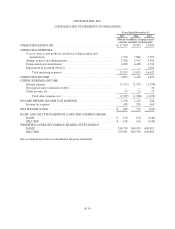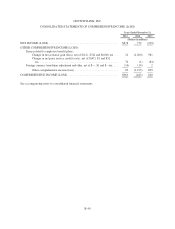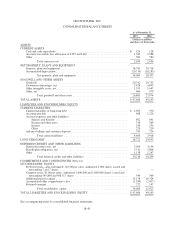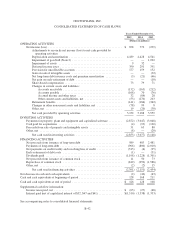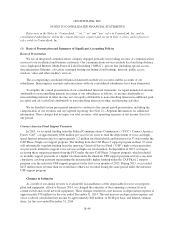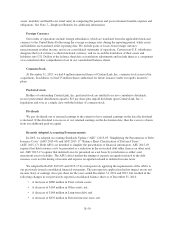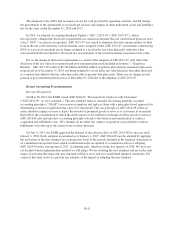CenturyLink 2015 Annual Report Download - page 155
Download and view the complete annual report
Please find page 155 of the 2015 CenturyLink annual report below. You can navigate through the pages in the report by either clicking on the pages listed below, or by using the keyword search tool below to find specific information within the annual report.Legal Costs
In the normal course of our business, we incur costs to hire and retain external legal counsel to advise us on
regulatory, litigation and other matters. We expense these costs as the related services are received.
Income Taxes
We file a consolidated federal income tax return with our eligible subsidiaries. The provision for income
taxes consists of an amount for taxes currently payable, an amount for tax consequences deferred to future
periods, adjustments to our liabilities for uncertain tax positions and amortization of investment tax credits. We
record deferred income tax assets and liabilities reflecting future tax consequences attributable to tax net
operating losses (“NOLs”), tax credit carryforwards and differences between the financial statement carrying
value of assets and liabilities and the tax bases of those assets and liabilities. Deferred taxes are computed using
enacted tax rates expected to apply in the year in which the differences are expected to affect taxable income.
The effect on deferred income tax assets and liabilities of a change in tax rate is recognized in earnings in the
period that includes the enactment date.
We establish valuation allowances when necessary to reduce deferred income tax assets to the amounts that
we believe are more likely than not to be recovered. Each quarter we evaluate the need to retain all or a portion of
the valuation allowance on our deferred tax assets. See Note 11—Income Taxes for additional information.
Cash and Cash Equivalents
Cash and cash equivalents include highly liquid investments that are readily convertible into cash and are
not subject to significant risk from fluctuations in interest rates. As a result, the value at which cash and cash
equivalents are reported in our consolidated financial statements approximates their fair value. In evaluating
investments for classification as cash equivalents, we require that individual securities have original maturities of
ninety days or less and that individual investment funds have dollar-weighted average maturities of ninety days
or less. To preserve capital and maintain liquidity, we invest with financial institutions we deem to be of sound
financial condition and in high quality and relatively risk-free investment products. Our cash investment policy
limits the concentration of investments with specific financial institutions or among certain products and includes
criteria related to credit worthiness of any particular financial institution.
Book overdrafts occur when checks have been issued but have not been presented to our controlled
disbursement bank accounts for payment. Disbursement bank accounts allow us to delay funding of issued
checks until the checks are presented for payment. Until the issued checks are presented for payment, the book
overdrafts are included in accounts payable on our consolidated balance sheet. This activity is included in the
operating activities section in our consolidated statements of cash flows.
Accounts Receivable and Allowance for Doubtful Accounts
Accounts receivable are recognized based upon the amount due from customers for the services provided or
at cost for purchased and other receivables less an allowance for doubtful accounts. The allowance for doubtful
accounts receivable reflects our best estimate of probable losses inherent in our receivable portfolio determined
on the basis of historical experience, specific allowances for known troubled accounts and other currently
available evidence. We generally consider our accounts past due if they are outstanding over 30 days. Our
collection process varies by the customer segment, amount of the receivable, and our evaluation of the
customer’s credit risk. Our past due accounts are written off against our allowance for doubtful accounts when
collection is considered to be not probable. Any recoveries of accounts previously written off are generally
recognized as a reduction in bad debt expense in the period received. The carrying value of accounts receivable
net of the allowance for doubtful accounts approximates fair value.
B-47




